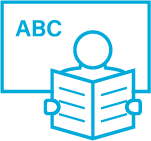Repeated Reading Effect on Reading Fluency and Reading Comprehension in Monolingual and Bilingual EFL learners

This study aims to investigate how repeated reading (RR) can affect reading fluency and comprehension among monolingual and bilingual English as a foreign language (EFL) students. An 8-week quasi-experimental RR study was conducted. Results suggested that the experimental group (n = 10 monolingual, n = 10 bilingual) in general gained in reading fluency and comprehended significantly more than the control group (n = 20). Bilingual comprehension performance was significantly different and higher than for monolingual students.
Author: Maryam Tafaroji Yeganeh
Source: Yeganeh, M.T. (2013). Repeated reading effect on reading fluency and reading comprehension in monolingual and bilingual EFL learners. Procedia – Social and Behavioral Sciences, 70, 1778–1786.
This study aims to investigate how repeated reading (RR) can affect reading fluency and comprehension among monolingual and bilingual English as a foreign language (EFL) students. An 8-week quasi-experimental RR study was conducted. Results suggested that the experimental group (n = 10 monolingual, n = 10 bilingual) in general gained in reading fluency and comprehended significantly more than the control group (n = 20). Bilingual comprehension performance was significantly different and higher than for monolingual students.
- Reading is an important skill in L1, L2, and foreign language (FL) settings and includes a laborious process.
- Many FL/L2 readers demonstrate a slow and effortful reading process, which is a result of underdeveloped word recognition skill of FL/L2.
- In L2/FL reading research, fluency has received scant attention.
- Fluency is defined as the ability to decode and to comprehend the text at the same time.
- Accuracy, speed, and appropriate expression in reading text (silently or orally) are main characteristics accompanied with fluency.
- RR is a means of developing fluency.
- This method has learners re-reading a short passage three or more times until they are able to read at criteria word per minute (wpm) level.

Study
This study aims to investigate how RR can affect reading fluency and comprehension among monolingual and bilingual EFL students.
Participants were 10 Persian monolingual and 10 Kurdish-Persian bilingual students. There were also 20 Iranian university students in the control group. A closed test was used to check pre-treatment equivalence of the experimental and control groups. The RR treatment text included 2 short stories segmented into 18 texts. Participants took pre- and post-tests, where they read the text five times and answered questions about the text after first and fifth reading.
Procedure
- The project was conducted over 8 weeks.
- The RR treatment applied the following procedure for the 18 treatment sessions:
- Students read each segment of a short story timing their own reading of a passage with a stopwatch.
- Students read the previous passage to remember what they had read in the last session.
- Students read the passage twice while listening to the exact audiotaped version with headphones.
- Participants finally read the text silently a fourth and fifth time and timed each of their readings with a stopwatch, marking each time on their time log sheet.
- Students wrote a short report about what they had read in the story passage.

Findings
- The results show that reading fluency for both monolingual and bilingual experimental group participants increased during the 8 weeks RR treatment.
- Reading fluency (on average) increased by 49 wpm for monolinguals and by 55 wpm for bilinguals on the first reading between the first and last RR session.
- On average, participants’ reading fluency on the fifth reading increased by 109 wpm for monolinguals and 110 wpm for bilinguals from first to last RR session.
- Participants reading fluency within RR sessions also increased.
- On the short answer first reading pre-test, the experimental group did not differ from the control group; however, by the fifth reading the control group read slower than the experimental group.
- On the first reading post-test, the experimental group read the test slightly faster than the control group, although this was not statistically significant, but by the fifth reading the experimental participants read faster than control group and the differences were statistically significant.
- The bilingual experimental group comprehended more than the monolingual and control groups.

Conclusions and implications
RR in general was effective in increasing reading fluency and comprehension among the experimental group compared with the control group. Bilingual students gained better comprehension ability than monolingual students. However, concerning fluency, no specific differences were found between monolingual and bilingual student performances. Thus, it can be concluded that in an FL setting, RR is an effective method to help readers (especially bilingual learners) to become independent.